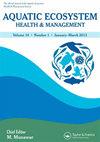河流鱼类对电导率梯度的响应——以太子江为例
IF 0.8
4区 环境科学与生态学
Q4 ENVIRONMENTAL SCIENCES
引用次数: 14
摘要
电导率升高对水生生物群产生渗透胁迫,进而改变生物群落。溪流鱼类对导电性的反应尚不清楚,保护策略也不完善。我们收集了太子河62个站点的鱼类和电导率数据,以评估鱼类群落和物种沿电导率梯度的变化。我们的研究结果发现,电导率升高与城市和农田的区域发展以及栖息地质量的局部退化有关。丰度和F-IBI的群落指标,而不是物种丰富度和多样性,与电导率呈显著的线性相关性。前三个F-IBI等级(优秀、良好和正常)的电导率显著低于其他两个F-IBI等级(较差和较差)的电导率。正常品位和不良品位之间的边界电导率约等于500μS cm−1。我们发现不同物种沿着电导率梯度的概率模式不同;一种捕获概率模式沿电导率梯度呈下降趋势。除两个优势广泛物种和一个耐受物种外,第一种模式的其余鱼类应被指定为保护对象。为了保护鱼类群落的完整性和敏感物种,集水区管理者应更加重视集水区规模的可持续土地利用管理和地方规模的栖息地质量改善。本文章由计算机程序翻译,如有差异,请以英文原文为准。
The responses of stream fish to the gradient of conductivity: A case study from the Taizi River, China
Conductivity elevation produces osmotic stress to aquatic biota and then alters biological communities. The responses of stream fish to conductivity remain unclear and strategies for protection are poorly developed. We collected data of fish and conductivity from sixty-two sites of the Taizi River to evaluate the changes to the fish community and species along the gradient of conductivity. Our results found that conductivity elevation was related to the regional development of urban and farmland and the local degradation of habitat quality. The community metrics of abundance and F-IBI, but not species richness and diversity, showed a significant linear correlation with conductivity. Conductivity of the top three F-IBI grades (excellent, good and normal) was significantly lower than those of the other two F-IBI grades (poor and bad). The boundary conductivity between normal grade and poor grade was approximately equal to 500 μS cm−1. We found different probability patterns for different species along the conductivity gradient; one capture probability pattern showed decline trend along the conductivity gradient. Except for two dominating and widespread species and one tolerant species, the remaining fish species of the first pattern should be designated as protection objects. In order to protect fish community integrity and sensitive species, sustainable land use management on the catchment scale and habitat quality improvement on the local scale should be given more attention by catchment managers.
求助全文
通过发布文献求助,成功后即可免费获取论文全文。
去求助
来源期刊

Aquatic Ecosystem Health & Management
环境科学-海洋与淡水生物学
CiteScore
1.70
自引率
0.00%
发文量
1
审稿时长
18-36 weeks
期刊介绍:
The journal publishes articles on the following themes and topics:
• Original articles focusing on ecosystem-based sciences, ecosystem health and management of marine and aquatic ecosystems
• Reviews, invited perspectives and keynote contributions from conferences
• Special issues on important emerging topics, themes, and ecosystems (climate change, invasive species, HABs, risk assessment, models)
 求助内容:
求助内容: 应助结果提醒方式:
应助结果提醒方式:


